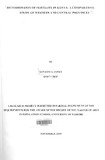| dc.description.abstract | Kenya has undergone a dramatic fertility transition with total fertility rate declining from 8.2 births per woman in the late 1970s to 4.7 towards the end of the 1990s. The 1998 and 2003 Kenya Demographic and Health Survey revealed that Kenyan fertility increased marginally from 4.7 to 4.9 revealing a stall in fertility. In Kenya regional variation in fertility levels have been experienced. For instance in'Central province fertility declined from 3.7 in 1998 to 3.4 in 2003 while, Western province recorded a rise from 5.6 to 5.8 during the same period. However there are limited studies focusing on fertility differentials at regional levels in Kenya and the factors responsible for fertility differentials in these two regions are not clearly known. This study therefore sought to establish the factors responsible for fertility differentials between Western and Central province.
The main objective of this study was to determine the factors that influence fertility levels among women of reproductive age group in Western and Central provinces in Kenya. The specific objectives were; to determine whether some selected socio-economic factors influence fertility differentials between Western and Central province; to establish how some selected demographic factors influence fertility differentials between Western and Central province; and to examine the influence of socio-cultural factors such as, age at first marriage, marriage patterns on fertility levels in Western and Central provinces.
Data was obtained from women aged 15-49 years who had given numerical responses to the question on total children ever born interviewed during 2003 KDHS. The sample size was 1,314 and 991 of women in Central and Western province respectively. John Bongaarts (1978) framework was used to conceptualize the study. The dependent variable was total children ever born. The study variables were marital status, place of residence, wealth index, education level, age at first birth, age at first marriage, ideal number of children, contraceptive use by method, type of marriage, and work status.
The tools of data analysis were simple and multivariate linear regression. The results of simple linear regression showed that, place of residence, wealth index, education level, and to some extend contraceptive use by method were all significantly associated with fertility level in the two regions. The results of multivariate analysis indicated that marital status, wealth index, education level, age at first birth; age at first marriage, ideal number of children, and contraceptive use by method were significant factors associated with fertility'levels in the two regions. Place of residence, type of marriage and work status were found not to be significantly associated with fertility.
However results on contraceptive use in Western showed that those who were not using any form of contraceptive had fewer children ever born compared to those using modern contraceptives. The study recommends support to expansion of secondary education opportunities for girls' education. especially secondary education and above, and support for the ongoing effort to reposition family planning services. The study also recommends further qualitative studies to address clearly why the differences in fertility levels in the two regions exist. | en_US |

